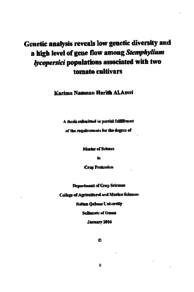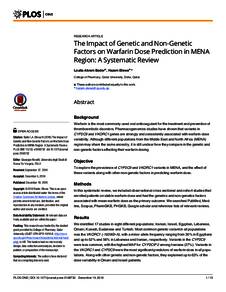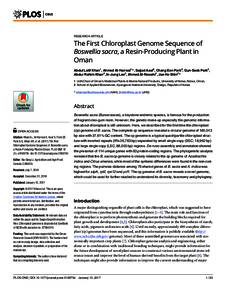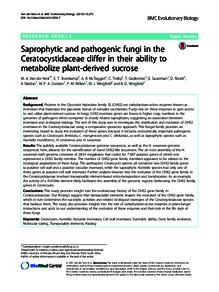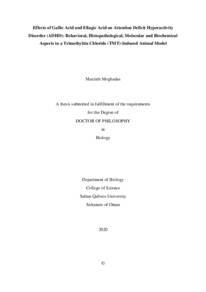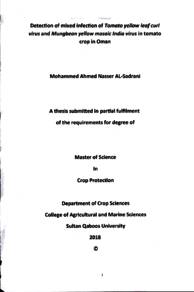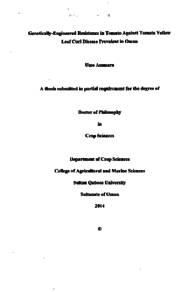وثيقة
Genetic analysis reveals low genetic diversity and a high level of gene flow among stemphylium lycopersici populations associated with two tomato cultivars
الناشر
Sultan Qaboos University
ميلادي
2016
اللغة
الأنجليزية
الملخص الإنجليزي
Stemphylium lycopersici is an important pathogen causing leaf spot and other diseases of tomatoes worldwide. Although much information is available about the pathogen, little is known about dynamics of S. lycopersici in tomato fields. Seventy-nine symptomatic leaf samples were collected from two tomato cultivars grown in a farm. Fungal species associated with the disease were isolated on potato dextrose agar. All isolates were identified as S. lycopersici based on sequence analysis of combined dataset of the internal transcribed spacer (ITS) and glyceraldehyde-3-phosphate dehydrogenase (gpd) regions. The 79 isolates obtained from the two cultivars were subjected to amplified fragment length polymorphism (AFLP) analysis using three primer combinations. The Stemphylium population from the two cultivars was found to have a very low level of genetic diversity (H = 0.0948). Cluster analysis showed intermixing of isolates from the two cultivars. In addition, analysis of molecular variance (AMOVA) showed the presence of a very low level of genetic differentiation between populations obtained from the two cultivars (Fst = 0.0206). These findings indicate the presence of a high rate of gene flow between the two populations and may suggest that the two populations originated from the same inoculum source. The implications of these findings on the management of Stemphyllium-induced leaf spot of tomatoes are discussed.
المجموعة
URL المصدر
الملخص العربي
يعتبر فطر ستيمفيليوم لايكوبيرسيكي من الفطريات الممرضة المهمة التي تسبب مرض تبقع الأوراق وأمراض أخرى على محصول الطماطم في أنحاء مختلفة من العالم. بالرغم من المعلومات الكثيرة المتوفرة عن هذا الممرض، لا يزال هناك شح في معرفة ديناميكية فطر ستيمفيليوم لايكوبيرسيكي على محصول الطماطم في الحقل. في هذه الدراسة تم جمع 79 عينة أوراق مصابة من صنفين من الطماطم المزروعة في احدى الحقول. وتم عزل الفطريات في وسط غذائي مناسب (PDA) وذلك لمعرفة نوع و أسم الفطر المسبب لهذا المرض. أدى التشخيص الى توصيف 79 - عزلة على أنها تنتمي لفطر ستيمفيليوم لايكوبيرسيكي ( Stemphylium) lycopersici وذلك باستخدام دراسة تسلسل القواعد الوراثية لمنطقة (gpd) ومنطقة (ITS) في الحامض النووي الريبوزي (rDNA). كما تم أيضا اجراء تحليل البصمة الوراثية (AFLP) وذلك باستخدام ثلاثة بادئات جينية (primers). أظهرت الدراسة عن وجود مستوى منخفض جدا من التنوع الجيني ( 0 . 0948 =H) لجميع عزلات فطر ستيمفيليوم من كلا الصنفين. كما أظهر التحليل أن هناك إختلاط بين عزلات الفطر من كلا صنفي الطماطم. بالإضافة إلى ذلك تم تأكيد هذه النتيجة باستخدام تحلیل (AMOVA) والذي أظهر وجود مستوى منخفض جدا من الاختلاف الجيني بين عزلات الفطر المعزولة من النباتات ( 0. 0206=F). هذه النتائج تشير إلى وجود نسبة عالية من التدفق الجيني بين عزلتي القطر ويرجح أن تكون العزلتان نشأتا من نفس المصدر. تناقش الدراسة سبل الاستفادة من هذه النتائج لإدارة مرض تبقع الأوراق الناتج بفعل فطر ستيمفيليوم على محصول الطماطم.
قالب العنصر
الرسائل والأطروحات الجامعية

